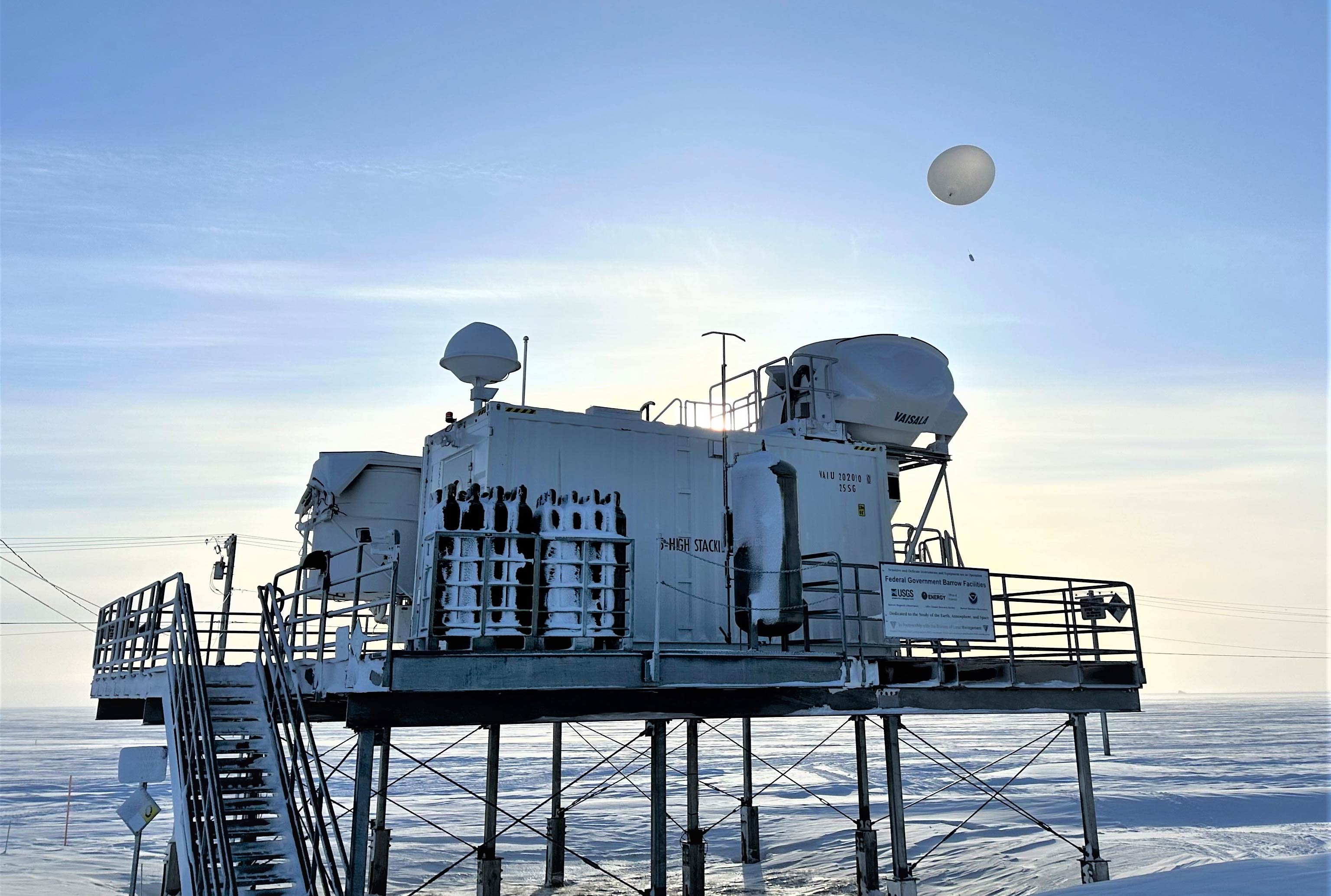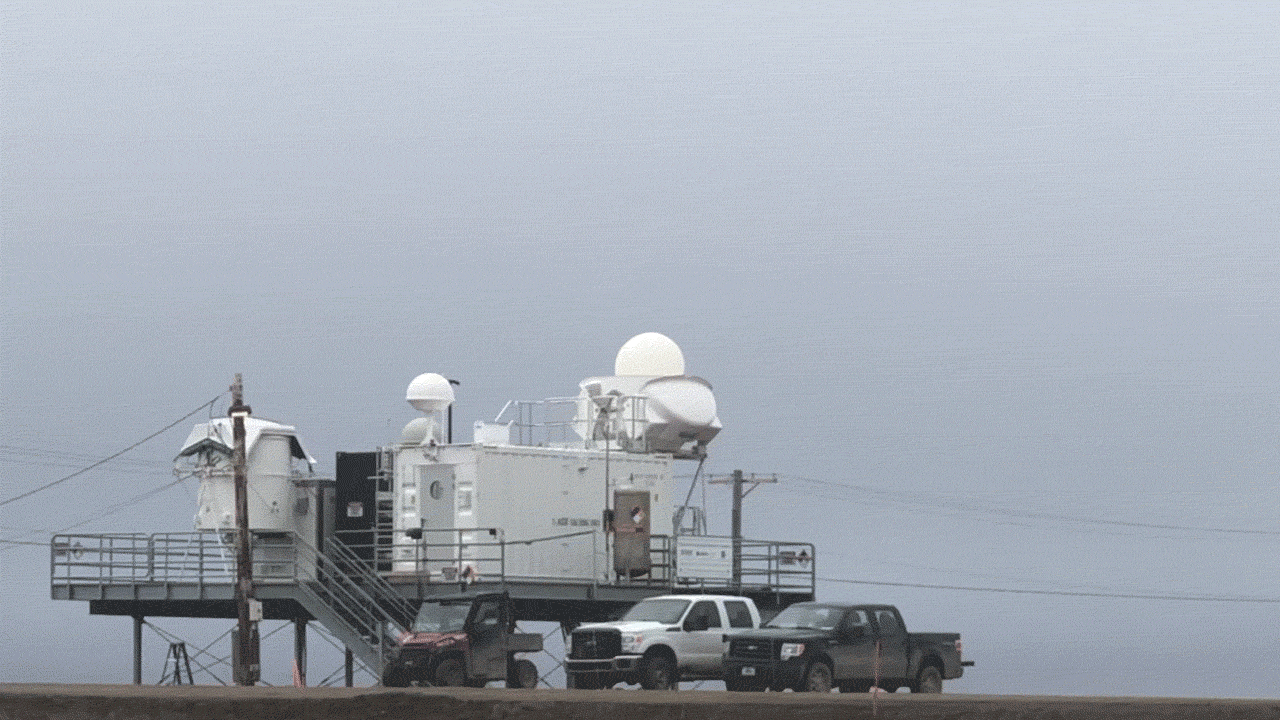North Slope of Alaska Switches to Hydrogen Weather Balloons
Published: 12 May 2023
Onsite hydrogen production reduces shipping costs, carbon dioxide emissions
Editor’s note: The original version of this story appeared on the Sandia National Laboratories website.

Hundreds of miles north of the Arctic Circle, Sandia National Laboratories researchers ensure the collection of important weather and climate data. By switching the gas used in their weather balloons, they have reduced their metaphorical footprint on the fragile Arctic ecosystem.
More than three years ago, the Sandia-operated atmospheric measurement facility in Alaska switched from launching helium-filled weather balloons to launching weather balloons filled with hydrogen produced onsite. Since then, they have launched nearly 5,000 hydrogen balloons with minimal issues.
This switch greatly reduces the transportation cost and emissions of shipping helium to Utqiaġvik, formerly known as Barrow, the northernmost city in the U.S. and site of the North Slope of Alaska atmospheric measurement facility.
The observatory, operated by Sandia for the U.S. Department of Energy Office of Science’s Atmospheric Radiation Measurement user facility, has collected weather and climate data, including specialized data on arctic clouds, for more than 25 years. ARM’s data are freely available to researchers at universities and national laboratories, and are vital for refining climate models, especially those of the rapidly warming Arctic.
The switch from non-renewable helium to hydrogen was made possible by a partnership between the National Weather Service and DOE. The National Weather Service provided the electrolysis equipment, which uses electricity to turn water into hydrogen gas and oxygen gas, and provided regular maintenance of the equipment. In exchange, the ARM facility operated by Sandia launches two weather balloons a day for the weather service.
“Between Utqiaġvik and Oliktok Point, a long-term ARM mobile deployment that ended operations in 2021, we were the largest users of helium in the state of Alaska,” said Fred Helsel, the systems engineer who led the effort to ensure the switch was safe and smooth. “The National Weather Service has been great to work with.”
Ensuring a Safe Launch
“It is in the interest of the nation and the world for us to reduce our dependence on a fossil fuel byproduct, helium, and reduce our carbon footprint by not transporting helium cylinders to the site.”
Andrew Glen, manager of both ARM’s North Slope of Alaska atmospheric observatory and Sandia’s atmospheric sciences research group
Now, this switch from helium to hydrogen is not without safety concerns — hydrogen is famously flammable, and helium is not — but Helsel worked with the National Weather Service, his division’s environment, safety and health coordinator, Sandia fire protection and pressure safety, the ARM user facility and the automated balloon launcher manufacturer to reduce the risks.
“Hydrogen is gaining traction as a green energy resource and is a cleaner alternative to traditional fossil fuels for transportation,” said Andrew Glen, manager of both ARM’s North Slope of Alaska atmospheric observatory and Sandia’s atmospheric sciences research group. “This project uses hydrogen in a different manner, utilizing its lighter-than-air properties to launch balloons. It is in the interest of the nation and the world for us to reduce our dependence on a fossil fuel byproduct, helium, and reduce our carbon footprint by not transporting helium cylinders to the site.”
One of the safety measures the team put in place includes ensuring that the hydrogen storage tank is outside the building where the electrolysis equipment operates. This reduced the amount of flammable gas available inside the building to meet national safety codes and Sandia’s requirements, Helsel said. Some of the National Weather Service sites that had already switched to hydrogen stored the tanks separately from the generator, but Sandia’s safety analysis did encourage the service to tweak their design for subsequent site upgrades, he added.
Sandia has been using an automated balloon launcher for more than a decade, but it occasionally has technical issues. When this happens, Utqiaġvik-based observers fill the ARM weather balloons with a backup supply of helium and launch them by hand. The facility does not have safety approvals in place to manually fill and launch a balloon with hydrogen, Helsel added.
Safety is also inherent within the automated balloon launcher. The balloon is filled with gas inside a launch tube that keeps the hydrogen outside of the launch building, Helsel said. And the launch tube has fans that ensure hydrogen cannot build up inside it, even if a balloon leaks or bursts during the inflation process.
Saving Money and the Environment

The first official hydrogen balloon was launched from Utqiaġvik on December 16, 2019, at 2:01 p.m. local time, said Helsel, with nearly 5,000 launches since then with only minimal issues. The original automated balloon launcher was replaced last August with a newer model.
The Utqiaġvik site launches four weather balloons a day, two for the National Weather Service and two for ARM. Each weather balloon carries a special package of sensors tens of thousands of feet into the stratosphere to collect and transmit data on atmospheric pressure, temperature, and humidity. The data from the National Weather Service balloons, which are launched every 12 hours, are used for weather forecasting. The data from the ARM balloons, which are launched six hours later, are used for atmospheric and climate research, Helsel said.
The facility in Utqiaġvik used to spend about $60,000 per year on helium and shipping costs for the ARM weather balloons, Helsel said. However, with the current helium shortage and inflation, the total saved in the past three and a half years due to the switch could easily be more than $200,000.
Much of the bulk material shipped to Utqiaġvik comes on a yearly barge from Anchorage, Glen said. “One ship, once a year,” he added. “If it’s not on that, it has to come on an aircraft.” And shipping large, compressed gas cylinders by air comes with a sizable carbon footprint on top of the emissions released from processing helium, he said.
Other ARM sites elsewhere in the U.S. are assessing whether it makes sense to also switch from helium—a byproduct of the oil and gas industry—to onsite or locally produced hydrogen, Glen said.
“The Arctic is a very tight-knit community, so keeping those relationships between the National Weather Service, National Oceanic and Atmospheric Administration, ARM, Sandia and the Iñupiaq people of Utqiagvik together is critical for getting things done up there,” Glen said. “The Arctic is a tipping point for climate change. We’re seeing four times the increase in temperature in the Arctic than in the rest of the U.S. The data from the ARM site are important for the long-term record and for climate models to take those changes into account.”
Keep up with the Atmospheric Observer
Updates on ARM news, events, and opportunities delivered to your inbox
ARM User Profile
ARM welcomes users from all institutions and nations. A free ARM user account is needed to access ARM data.


















